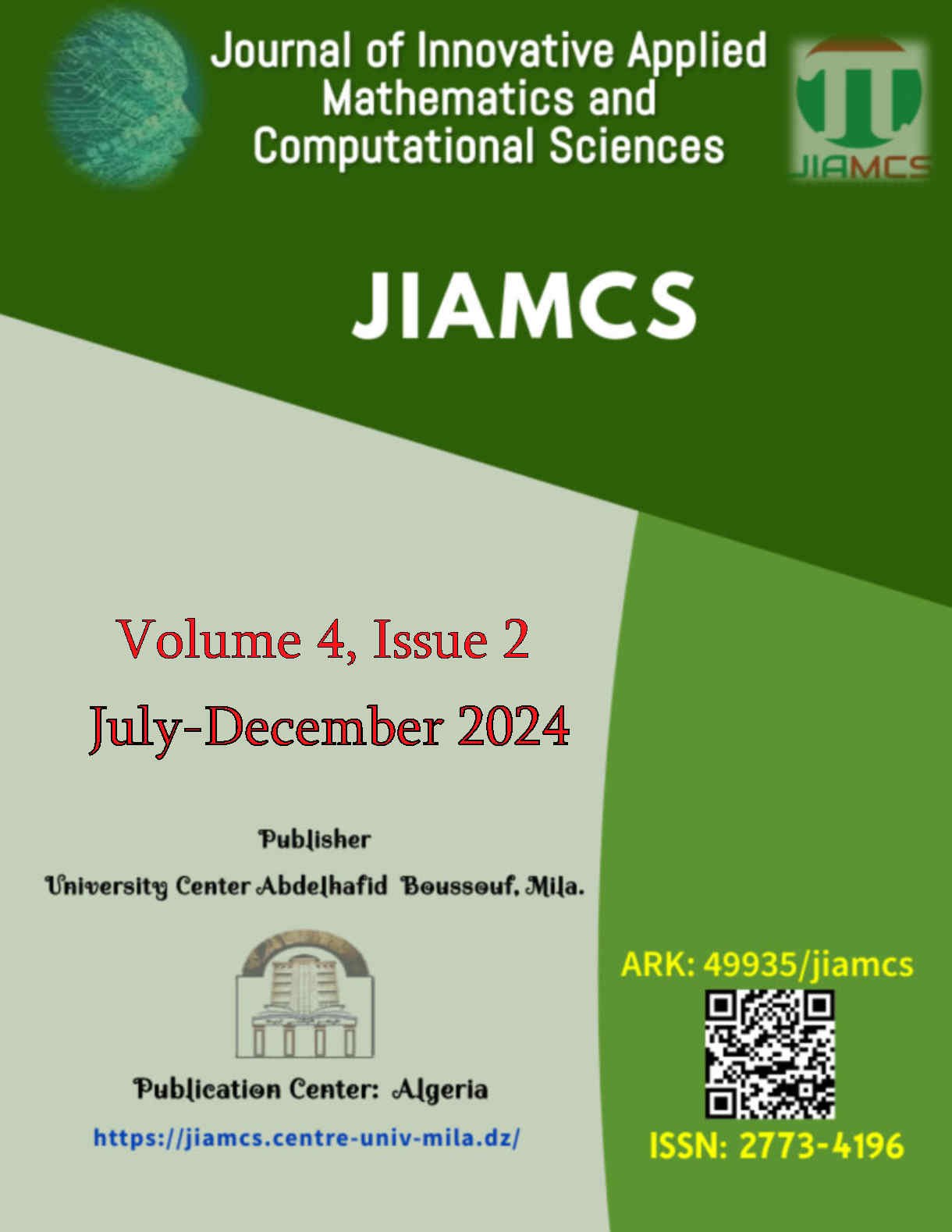Hydromagnetic nanofluid flow with Lorentz force, viscous dissipation, Dufour effect, first-order chemical reaction and unsteadiness
Main Article Content
Abstract
The objective of the study was to investigate hydromagnetic nanofluid flow with Lorentz force, viscous dissipation, Dufour effects, first order chemical reaction and unsteadiness and considering the flow between parallel plates by formulating necessary mathematical model. The study considers the dynamic viscosity and thermal conductivity of the fluid as temperature-dependent variables. The fluid is assumed to be incompressible in terms of density, and the influence of gravitational effects is deemed negligible. The governing equations for the non-Newtonian nanofluid flow, including the continuity, Navier-Stokes, energy, magnetic induction, and concentration equations, have been formulated and transformed into their non-dimensional form. Finite difference numerical approximation method has been used to approximate the systems of the governing equations in different forms. The profiles of the flow variables have been presented and analyzed. The results indicate that an increase in the thermophoresis parameter enhances the species concentration, whereas higher Schmidt numbers and chemical reaction parameters lead to a reduction in concentration profiles. Additionally, magnetic induction profiles increase with a higher Reynolds number but decrease with an increasing magnetic Prandtl number. Temperature and velocity profiles increase with an increase in Reynolds number. The study is essential in the improvements of both heat and mass transfers.
Downloads
Article Details

This work is licensed under a Creative Commons Attribution-NonCommercial-NoDerivatives 4.0 International License.
- Authors keep the rights and guarantee the Journal of Innovative Applied Mathematics and Computational Sciences the right to be the first publication of the document, licensed under a Creative Commons Attribution-NonCommercial-NoDerivatives 4.0 International License that allows others to share the work with an acknowledgement of authorship and publication in the journal.
- Authors are allowed and encouraged to spread their work through electronic means using personal or institutional websites (institutional open archives, personal websites or professional and academic networks profiles) once the text has been published.
References
[1]H. A. Attia, and N. A. Kotb, MHD flow between two parallel plates with heat transfer, Acta mechanica, 117(1) (1996), 215–220. DOI
[2]Y. M. Chu, S. Bashir, M. Ramzan, and M. Y. Malik, Modelbased comparative study of magnetohydrodynamics unsteady hybrid nanofluid flow between two infinite parallel plates with particle shape effects, Mathematical Methods in the Applied Sciences, 46(10) (2023), 11568– 11582. DOI
[3]M. Danny, T. Kafunda, K. Christian, and J. Stanley, Analysis on Heat and Mass Transfer in Boundary Layer Non-Newtonian Nanofluid Flow Past a Vertically Stretching Porous Plate with Chemical Reaction, Variable Magnetic Field and Variable Thermal Conductivity, Interna- tional Journal of Advanced Applied Mathematics and Mechanics, 11(4) (2024), 1–14.
[4]A. S. Dogonchi, M. Waqas, S. R. Afshar, S. M. Seyyedi, M. Hashemi-Tilehnoee, A. J. Chamkha, and D. D. Ganji, Investigation of magneto-hydrodynamic fluid squeezed between two parallel disks by considering Joule heating, thermal radiation, and adding different nanopar- ticles, International Journal of Numerical Methods for Heat and Fluid Flow, 30(2) (2020), 659–680. DOI
[5]M. D. Ikram, M. I. Asjad, A. Akgül, and D. Baleanu, Effects of hybrid nanofluid on novel fractional model of heat transfer flow between two parallel plates, Alexandria Engineering Journal, 60(4) (2021), 3593–3604. DOI
[6]T. Kafunda, M. Danny, K. Christian, J. Stanley, and E. Ambe, Unsteady hydromagnetic non-Newtonian nanofluid flow past a porous stretching sheet in the presence of variable magnetic field and chemical reaction, Journal of Applied Mathematics and Physics, 11(9) (2023), 2545– 2567. DOI
[7]D. Kumar, A. Singh, and D. Kumar, Effect of Hall current on the magnetohydrodynamic free convective flow between vertical walls with induced magnetic field, The European Physical Journal Plus, 133(5) (2018), 207. DOI
[8]L. Lugo, J. P. Vallejo, G. Zyla, and J. Fernandez-Seara, Rheological behaviour of func- tionalized graphene nanoplatelet nanofluids based on water and propylene glycol: water mixtures,
International Communications in Heat and Mass Transfer, 99 (2018), 43–53. DOI
[9]R. Mohebbi, S. Mehryan, M. Izadi, and O. Mahian, Natural convection of hybrid nanofluids inside a partitioned porous cavity for application in solar power plants, Journal of Thermal Analysis and Calorimetry, 137 (2019), 1719–1733. DOI
[10]N. Mwamba, J. Okelo Abonyo, K. O. Awuor, B. Otieno, A. Lwande, and J. O. Owino, Effects of thermal radiation and chemical reaction on hydromagnetic fluid flow in a cylindrical collapsible tube with an obstacle, International Journal of Mathematics and Mathematical Sciences, (2023). DOI
[11]M. Ramzan, S. Inam, and S. Shehzad, Three-dimensional boundary layer flow of a viscoelastic nanofluid with Soret and Dufour effects, Alexandria Engineering Journal, 55(1) (2016), 311–
319. DOI
[12]A. M. Rashad, A. J. Chamkha, M. Ismael, and T. Salah, MHD Natural Convection in a Triangular Cavity filled with a CuAl2O3/Water Hybrid Nanofluid with Localized Heating from Below and Internal Heat Generation, Journal of Heat Transfer, 7 140(7) (2018), 072502. DOI
[13]S. A. R. Sahebi, H. Pourziaei, A. R. Feizi, M. H. Taheri, Y. Rostamiyan, and D. D. Ganji, Numerical analysis of natural convection for non-Newtonian fluid conveying nanopar- ticles between two vertical parallel plates, The European Physical Journal Plus, 130 (2015), 1–12. DOI
[14]S. Salehi, A. Nori, K. Hosseinzadeh, and D. D. Ganji, Hydrothermal analysis of MHD squeezing mixture fluid suspended by hybrid nanoparticles between two parallel plates, Case Studies in Thermal Engineering, 21 (2020), 100650. DOI
[15]A. Shahsavar, M. Moradi, and M. Bahiraei, Heat transfer and entropy generation opti- mization for flow of a non-Newtonian hybrid nanofluid containing coated CNT/Fe3O4 nanopar- ticles in a concentric annulus, Journal of the Taiwan Institute of Chemical Engineers, 84 (2018), 28–40. DOI
[16]J. P. Vallejo, L. Lugo, G. Zyla, and J. Fernandez-Seara, Influence of Six Carbon-Based Nanomaterials on the Rheological Properties of Nanofluids, Nanomaterials, 9(2) (2019), 146. DOI
[17]A. S. Yadav, R. K. Khare, and M. James, Fluid flow through porous medium in a horizontal channel in inclined magnetic field, Journal of Applied Science and Computations, 6(1) (2019), 1223–1226.




